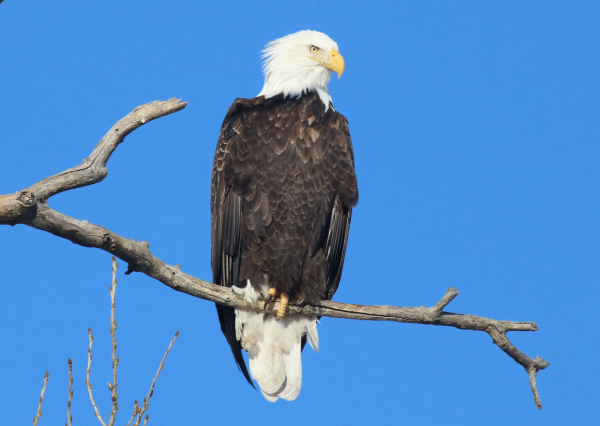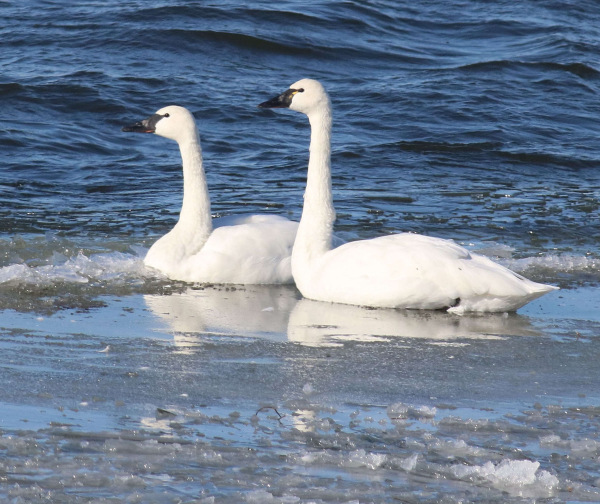
Amid the skeletal old cottonwoods, a hardy Bald Eagle was among the few birds found in the open plains near home this week.

Although the sight and sounds of hundreds of Tundra Swans on the ice and in the air can’t be conveyed in these close images, they do represent the beauty and grace of these large waterfowl.

Two young swans are included in this resting family group of Tundra Swans that will soon be headed for the East Coast.
|
The stunning white swans were flying in formation overhead in almost every direction, while in the center of the scene swans lined the edge of the open water of a large lake, standing on the edge of the ice and in small flocks a few yards beyond the icy shore. I love the sounds of Tundra Swans, and the haunting chorus provided by this concentration of late-season swans was memorable. An interesting migration point about this giant waterfowl species is that the Tundra Swans that nest in the Canadian Arctic tend to migrate south until they reach the Dakotas, then make an abrupt turn to the east and continue to the Atlantic Coast, where they winter in an area that centers in Chesapeake Bay. That would be a unique migration route, except that Canvasbacks make a similar fall journey, which is probably based on the two species’ preference for feeding on eelgrass.
Minnetonka Birds
With most lakes and wetlands in the Twin Cities area frozen, Lake Minnetonka became a late-season haven for many Thanksgiving birds on the west side of the metro area. The most common birds on the big lake and its myriad bays were Common Mergansers, with flocks of hundreds of plying the icy waters for what must have been uncountable small fish. One bay in particular held a substantial flock of Common Goldeneyes, and there were widely scattered small groups of Mallards and Canada Geese along the shores. Overlooking the flocks of waterfowl were even more widely scattered Bald Eagles, only numbering three each day, a like number that I left behind in my home territory.
Other birds I observed that have evacuated my home range included American Crows, Ring-billed Gulls, a couple Red-tailed Hawks, and that’s about it. I frankly never saw a songbird or similar-sized species – no cardinals, chickadees, or woodpeckers availed themselves, but my Mom enjoyed getting out to see the ducks, geese, and eagles on our way to a nice Thanksgiving dinner, especially with all the trees covered with a layer of new snow – it looked more like Christmas, she noted.
Area Sightings
After returning back to North Dakota late-night Thursday, I’m sorry to say that during a foggy birding drive Friday afternoon, I only observed one bird, a wary Ring-necked Pheasant that quickly slipped back into cover. This northern region seems to be cleared out – probably with good reason: A couple hours later a blizzard began raging for the next 40 hours with more than a foot of snow being blown into drifts, probably to remain until March (or July – ha-ha). Even my feeding station seemed abandoned, with my usual feeder visitors replaced by a funky gang of Euro Starlings and House Sparrows – dang; I leave for a couple days and the place gets overrun by birds I’ve been trying to avoid. What do I do now? Adapt and enjoy? Change my menu? Hmmm.
There was no travel possible over the weekend, but I was able to venture into the snow-covered surrounding area again Monday. I was glad to see there were still a couple Bald Eagles in the area, one flying 11 miles south of home and one perched amid the skeleton trees lakeside 6 miles north, where I also observed a Blue Jay. At home, I seem to have eliminated the starling invasion by not filling my suet feeder. That’s a short-term blow to the woodpeckers I enjoy seeing, but they still grab a few seeds occasionally, and I’m hoping the starlings will move on. Otherwise, I’ll need to try switching to an upside down model of suet feeder as soon as possible.
Article and photos by Paul Konrad
Share your bird sightings and photos at editorstbw2@gmail.com